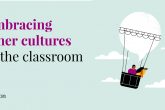
Oliver Omotto tells a story of how Greensteds International School’s approach to transforming student behaviour.
What is restorative practice?
Reducing friction in the classroom and maintaining a positive atmosphere requires a set of skills and techniques which support the culture of the school. It is the responsibility of the teacher to reduce the amount and severity of intrusion on student learning. We at Greensteds International School have been trying out restorative practice approach to behaviour management.
Restorative practice takes place at the classroom level with lower level incidences and is aimed at building relationships between teachers and children. One of the reasons why we prefer restorative practice here is because from experience so many teachers have found themselves caught up in the cycle of punishment. There is no evidence that you can simply punish children out of behaving badly and that is why we need a restorative approach to behaviour management.
Whatever setting you are working within, restorative practice techniques can transform behaviour, restore and – crucially – improve relationships. For effective reflection, the following six questions should be used in all restorative meetings with learners:
- What has happened?
- What were you thinking at the time? (teacher and student)
- Who has been affected by the actions?
- How have they been affected?
- What needs to be done now to make things right?
- How can we do things differently in the future?
The objective is to modify behaviour rather than just punishing it. Restorative practice seeks to restore the trust between the adult and the young person, restoring the boundaries, and starting the next day on a clean sheet. These six questions have provided good opportunities for teacher-student reflection especially during isolation and thinking time rather than just asking a child to sit alone and stare at a whiteboard.
Teachers’s are encouraged to attend the meetings and hold discussions with the students they have referred to the restorative meetings using the 6 questions. The students walk away from the meetings with an improved opinion about the teacher and ready to meet the teacher again and learn from them the following day. This has a much better impact compared to sending children straigh-away to the senior management to deal with behaviour issues.
What is Ready to Learn?
We would like to inform you about a development to our behaviour policy, known as Ready to Learn. This is a behaviour management strategy, which has at its heart a drive to improve the quality of learning for all our students and to ensure that every child is able to achieve excellent progress here at Greensteds International School. We have very little behaviour problems here at GIS, and this new initiative is to combat low level disruption in the classroom, and reinforce our need for every student to be ready to learn.
In the classroom, the Ready to Learn strategy gives clear expectations for teachers and students to enable teachers to teach and students to learn effectively. This is a straightforward system. It does not represent a change in our values and expectations, however it does enable decisive action to be taken straight away to ensure that these expectations are consistently and rigorously applied. It is based on the understanding that where students show that they are not ready to learn i.e. late for lessons, or disrupting the learning of others they should be picked up on it straight away to reinforce expectations. (Read ‘managing behaviour for learning strategies that can be used in the classroom to divert and diffuse low level disruption’).
Essentially, the aims of the system are:
- To eliminate all disruptive behaviour, so that there is a positive and scholarly culture where students take learning seriously and no learning time is wasted.
- To provide clarity for staff and students about acceptable behaviour and the consequences of poor behaviour or behaviour that means students are not ready to learn.
- To foster an environment of mutual respect between staff and students
- To encourage students to be self-motivated and responsible, independent learners who take responsibility for their own actions
- To enable teachers to deliver lessons that inspire, engage, challenge and support students to reflect on their learning in a positive learning environment free from interruptions.
In class, the teacher will give warnings to any student who is not meeting the Ready to Learn expectations. If this is repeated, he/she will be required to meet up with one of the senior teachers after school at 3.15pm. After discussion of the issue they have been referred for students will be required to give an undertaking to desist such actions. For more serious/ repeat disruption to learning detentions are set straight away.
The class teacher is informed of the outcome of the discussions, and where appropriate is involved in a restorative conversation, so that the issue can be resolved, and to support future learning.
We appreciate that some students have additional educational needs which make it more difficult for them to regulate some aspects of their behaviour; these students recieve our complete support. The strategy, therefore, includes a tariff of reasonable adjustments which are personalised for individual students. An intervention and support programme is implemented if the student has multiple incidents of poor behaviour.
Should a child disrupt the learning in class, it is important for parents and carers to note that the same day detention will not interfere with transport arrangements or after school activities as detentions are set in their free time. This system started this half term and has been very effective in helping our students maintain their focus in lessons.
Applying these clear standards of learning behaviour enables opportunities for teachers and students to be creative in their approach to learning, which in turn leads to inspiration, motivation and progress.
Research and further reading
Ready-to-Learn: behaviour management strategy at Greensteds International School
Managing Behaviour for Learning: Strategy Checklist
Restorative Approaches in Schools in the UK
Raising Behaviour: A School View
DfE Report: Behaviour and Discipline in Schools
[Photo by Jessica Ruscello on Unsplash]
About the author
Oliver Omotto is Senior Teacher and Head of Faculty at Greensteds International School in Nakuru, Kenya. His teaching experience spans over a duration of 12 years. He works as Examiner for A Level Media Studies and also holds international accreditation as a professional development leader alongside another Pearson OSCA accreditation as Level 3 BTEC Lead Verifier for Creative Media Production. He blogs on a wide range of educational issues.

